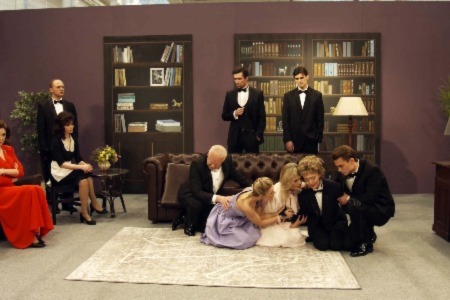In 1992, after the dissolution of the Soviet Union, the American soap opera Santa Barbara became a window into the western way of life for ordinary Russians. The show became hugely popular with the entire nation.
Thirty years later, director Gaukur Úlfarsson takes us along with Icelandic contemporary artist, Ragnar Kjartansson to Moscow as he brings the series to life as a living sculpture set to open an oligarch’s private museum.
In Soviet Barbara, the Story of Ragnar Kjartansson in Moscow, cameras are set up to observe the installation and unexpected negotiations of the Ragnar’s vision.
With unprecendent access, Úlfarsson captures the negotiations the artist and curators have when some of Ragnar’s work is found to be a bit too ‘provocative’ for Russian audiences. In Ragnar fashion, he creates a new piece and plans continue.
Ragnar then focuses on mounting of the onceptually and physically massive show Santa Barbara – A Living Sculpture. The plan is to record 100 episodes of the series over 100 nights with local actors. The creators of the soap opera even come to Moscow to be part of the experience and learn first-hand how much the series has impacted Russians young and old over the last 30 years. This living sculpture also serves as commentary between Western capitalism and the collapse of the Soviet empire.
The museum opening is a great success. What makes the opening even more special to Ragnar is a visit from Pussy Riot member Maria Vladimirovna “Masha” Alyokhina. To Ragnar, Masha’s visit makes the opening a success in his eyes. Since he labels his works as socialist, the presence of such a big figure in Russian art and activism is part of the reason he creates the works he does.
Soon after the museum’s official opening, the Russian forces eventually invade Ukraine. Without hesitation, Ragnar shuts down the exhibition. There is no way he can leave his artworks up when Russia is destroying Ukraine.
Soviet Barbara captures the cultural dialogue between rival superpowers in the last days of the cold war, and the way ordinary people in Russia lived through times of dramatic change. Now, thirty years later, dreams of cultural openness turned to dust after the invasion of Ukraine.
The film also offers an insightful look into the ideas of one of today’s biggest names in contemporary art. During the film’s premiere at Hot Docs, I spoke with director Gaukur Úlfarsson to learn more about the Ragnar, the artist, and the making of this very thought provoking film.







